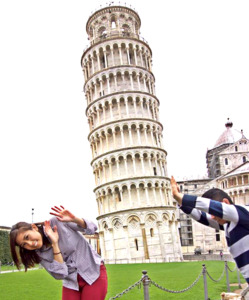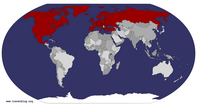Advertisement
Published: March 7th 2016

 Leaning Tower of Pisa
Leaning Tower of Pisa
Typical tourist photo with the TowerTuscany is more synonymous to wine than Justin Bieber is to tattoos, only much easier on the eyes. But travelers don't realize the region offers more than just grape juice, such as art, history, and Kristina's favorite, food. When the combined genius of Leonardo da Vinci, Galileo, Fibonacci, Machiavelli, Amerigo Vespucci, Petrarch, Dante, and even Pinocchio called this place home, there's plenty to keep one happy and hungry. So join the party of millions who have been enchanted by the rolling hills of cypress trees and pull up a seat with a glass of merlot... because everything just feels better with a touch of alcohol.
The most important thing to recognize about Italy is that it's barely older than the oldest person on record (Jeanne Calment, born 1875). Before their unification in 1861, each town was its own entity, waging war against one another over pickles if they could. Some cities still harbor so much dislike for their neighbors they omit road signs directing travelers to nearby towns, leaving foreign drivers confused. Hence why it's so important to come prepared with a map and skilled navigator if you plan on doing a tour of Tuscany by car.
We began

 Siena
Siena
Taking a rainy passiagata through the cobbled streets of Sienaour trek around the region in Florence, moved west to Lucca and Pisa, followed by San Gimignano and Siena to the south. Lucca was a silk magnate whose Renaissance walls have attracted travelers for ages; Pisa, a maritime giant during the 11th century, rivaled only by Venice and Genoa; San Gimignano, a mercantile center whose skyline of towers earned it the nickname, "the Medieval Manhattan"; and Siena, a banking powerhouse that many now proclaim is the "Gem of Tuscany." Since learning about the cities' background is crucial before visiting, we dusted off our textbooks for a quick glance. A little history lesson only enhances the experience, so brush up on your research prior to coming.
Our group visited Lucca on a rainy morning after a hectic trip to Rome, making for a lazy day to catch our breath. This sleepy town is an hour's drive west of Florence, standing in stark contrast to its more famous neighbor. The walls that Napoleon converted to walking paths played as much a vital role in the city's past as it does today. While it was used to keep invaders out during the Renaissance, it now serves as the main attraction drawing tourists

 San Gimignano
San Gimignano
Known as "the Medieval Manhattan" for the 14 towers dotting its skylinein. If you plan on arriving here by car like us, there's free parking just outside the walls along Via Fabio Filzi, Via Pubblici Macelli, and Piazzale Don Francesco Baroni (for a map of parking in any Italian city: en.parkopedia.it). There are only seven gates into the city, so ZTLs are only a concern if you somehow drove through one of these well-marked entrances.
Once we made our way into the city, our group headed to the Duomo di San Martino, where the Volto Santo (Holy Face) stands. This wooden sculpture was supposedly carved by Nicodemus, who removed Jesus' body from the cross after his crucifixion. We then moved on to the Guinigi Tower, the city's most famous tower with a garden on top offering the best views. It was built by Lucca's most powerful family as a display of wealth and is one of two towers allowing visitors to climb for a fee.
Afterwards, we continued north to Piazza del Anfiteatro, a former Roman amphitheater (thus the name) that was converted to a public square. The four arched gates were used by gladiators to enter this mini-Colosseum in its heyday, which today is used as a street

 Piazza del Campo
Piazza del Campo
Site of the famous Palio horse-race held twice annuallymarket and gathering spot for locals. The town's main avenue, Via Fillungo, runs west of this piazza, which we meandered down for some window shopping. This street led us to Chiesa di San Michele, an 11th century wedding-cake church famous for its panel paintings by Lippi. The facade is taller than the church itself because money was exhausted before construction could be completed.
Once we finished admiring the church, we strolled south towards Piazza Napoleone, which was designed by Napoleon's sister in 1806 and was the site of performances by Elton John, Bob Dylan, and Santana. Nearby is a theater showcasing the city's rich music history, and because Lucca is the birthplace of Giocomo Puccini--one of Italy's most acclaimed opera composers--pop in for a quick concert if time permits.
Since we were in a time crunch, our family opted instead to move on to Pisa. Again, there's free parking along Via Lucchese and Via Ugo Rindi outside the ZTLs, a mere 5-minute walk into the historical center. This once prominent port city still boasts an impeccable reputation among travelers. The most popular destination, the Leaning Tower, is visible from a distance and should be the starting point for

 Trattoria la Ghiotteria
Trattoria la Ghiotteria
Gorgonzola ravioli, truffle ravioli, seafood pasta, and chicken breast any itinerary. Like typical tourists, we snapped a gazillion photos of us holding up the Tower, but don't spend all your time here. The square surrounding it, Piazza dei Miracoli, is a UNESCO World Heritage Site that also contains the Duomo--which had the largest elliptical dome in the world when it was built in 1064 A.D.--and the Baptistry--where Galileo was baptized.
We then walked south along Via Santa Maria to Piazza dei Cavalieri (Knight's Square), the city's political center. The Palazzo della Carovana that faces the plaza is now property of the University of Pisa, one of the world's leading educational institutions. Few realize that this college is the Princeton of Italy, whose graduates include 3 Nobel laureates, 2 Italian presidents, 5 Popes, and 5 prime ministers.
Afterwards, we continued south to Piazza delle Vettovaglie, a great food market to stock up for a picnic. Since it was raining, we skipped it to cross the Arno to the south bank and walked along Corso Italia, Pisa's main shopping avenue anchored by Piazza Vittorio Emanuele II. Because it was dinnertime and the downpour was worsening, we hopped into a quaint restaurant called Trattoria la Ghiotteria (9 Vicolo delle Donzelle).

 Caffe Giardino
Caffe Giardino
An intimate restaurant serving bruschetta, pasta, and the famous regional wine using vernaccia grapesThis favorite hang-out for locals offered authentic cuisine, including gorgonzola ravioli, truffle ravioli, seafood pasta, and chicken breast. The food was amazing and the setting cozy, ending our fun, albeit rainy, day in Lucca and Pisa.
A couple days later, we set out for San Gimignano and Siena, both within a 2-hour drive south of Montecatini Terme, our homebase. San Gimignano has 4 parking lots, but the cheapest is P1-Giubileo on Via Antonio Gramsci (Є1.50/hour, Є6 daily cap). Another is P2-Montemaggio (Є2/hour, Є20 daily cap). We chose the former due to the daily cap, but there are also free parallel spaces leading up to P1 near the city walls if you're lucky enough to find one. Once inside the historic center (a designated UNESCO site) through the south entrance called Porta San Giovanni, we walked along the main street to Piazza della Cisterna. This social heart of San Gimignano has a well in the square's center built in 1287 that provided residents with water, but also acted as a place for public executions. The square is overshadowed by 2 of the 14 remaining towers that made this town internationally renown, so grab some gelato from Gelateria Dondoli (4 Piazza

 Chiesa di San Michele
Chiesa di San Michele
A wedding-cake church famous for its panel paintings by LippiCisterna)--which was declared the world's best gelato in 2007 and 2009--and enjoy it under this gorgeous backdrop.
When finished, continue north to another square, Piazza delle Erbe and Piazza del Duomo, the political heart of the city. The Duomo, Palazzo del Popolo, and 7 towers surround this square, so soak in the beautiful architecture before moving on to Rocca di Montestaffoli, a 14th century fortress turned park by the Sienese when they ousted the Florentines from San Gimignano. The stairs leading to the top afford the best panoramic of the city, offering spectacular views of the Tuscan countryside.
We ended with lunch at Caffe Giardino (17 Viale Roma), an intimate family-owned trattoria serving the freshest dishes we tasted in Italy. Kristina ordered the bruschetta with sun-dried tomatoes and balsamic vinegar, I got the bruschetta with bacon, Kristina's parents tried the pasta with meat sauce, and we washed it down with the famous white wine made from the regional vernaccia grapes. This was our favorite meal during the entire trip because the picturesque setting in a homey atmosphere with delicious food and a tasty wine were the perfect remedy for a rainy day.
Our next stop was Siena,

 Tuscan Countryside
Tuscan Countryside
View atop the Rocca di Montestaffolithe crown jewel of Tuscany. The cheapest paid parking is on the street at 60 Via Roma in the blue spaces (white spaces are free, yellow are for residents), which charges Є1.50/hour. Pay at the green machines and display the receipt on your dash, but be aware of the ZTL straight ahead, so make sure not to enter inadvertently.
We walked 10 minutes from our parking spot to Piazza del Campo, the surprisingly large public square where the famous Palio horse races are held twice annually. This event dates back to the Middle Ages when bullfighting and jousting were hosted in the Campo, but when bullfighting was banned in 1590, the locals switched to racing horses bareback. The Palio progressed into a global attraction, whereby outsiders come to witness the pageantry preceding the event. Unfortunately for us, these races take place on July 2 and August 16 each year, so we couldn't enjoy the festivities first-hand. Instead, we explored the cobbled streets and back-alleys of Siena before returning to our car to make the drive home.
All in all, an appropriate end to our packed itinerary around Tuscany. Each town offered something different, but our favorite was undoubtedly

 Palazzo della Carovana
Palazzo della Carovana
Now part of the University of Pisa, a world-renown educational institutionPisa for its gorgeous landmarks and San Gimignano for its unmatched character. The olive groves and truffle fields alone are enough to warrant a visit, but if you're lucky to stay in this region for an entire week like us, don't stop at just one glass of wine or a cup of gelato. These hills provide you with experiences you've never imagined, so don't take your time in Tuscany for granted, because each bite and every breath here will stay with you for a lifetime.
Advertisement
Tot: 0.354s; Tpl: 0.013s; cc: 17; qc: 66; dbt: 0.0787s; 1; m:domysql w:travelblog (10.17.0.13); sld: 1;
; mem: 1.4mb














nancic123
Nanci and David Curry
Very Nice!
Can't wait to get here!